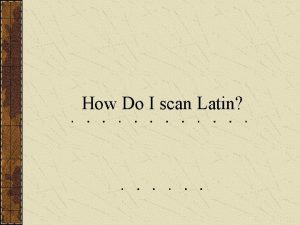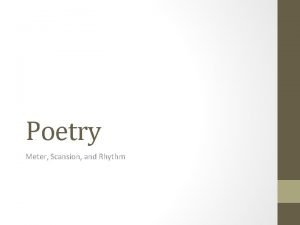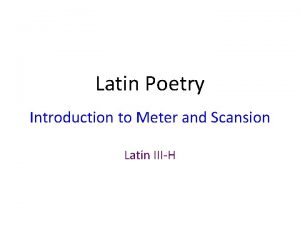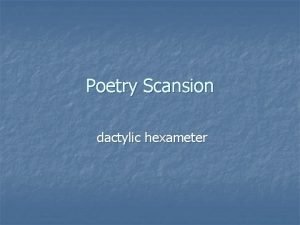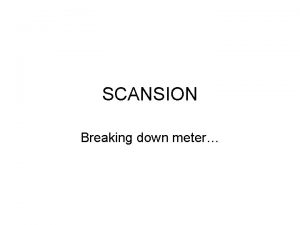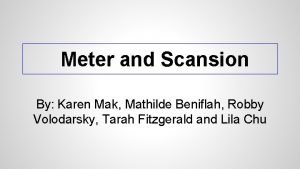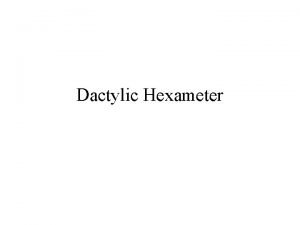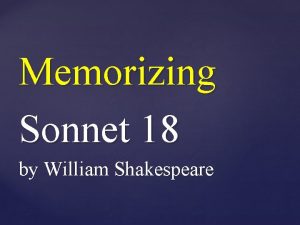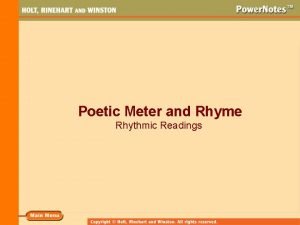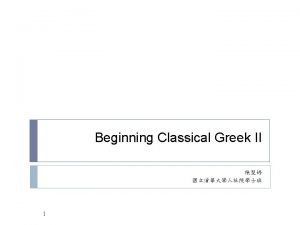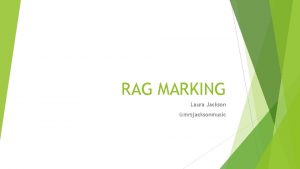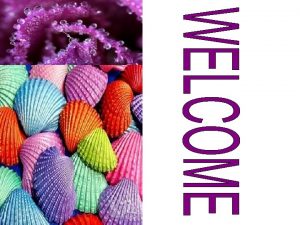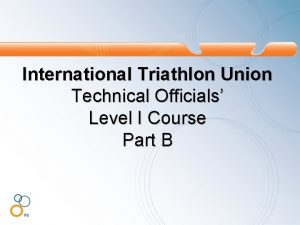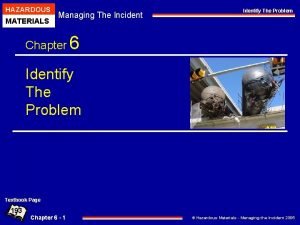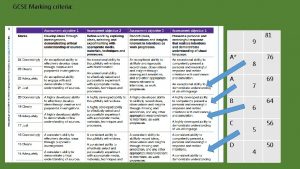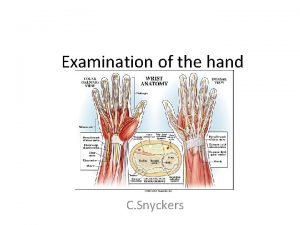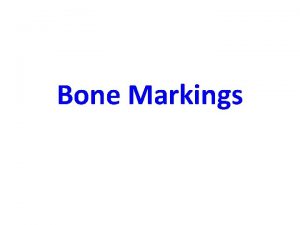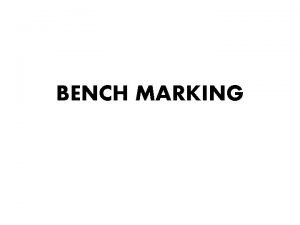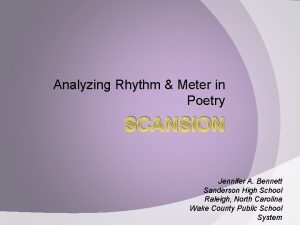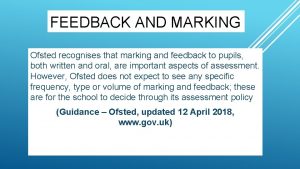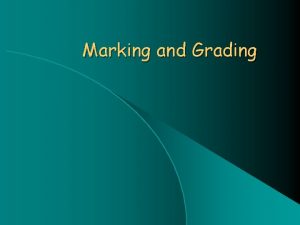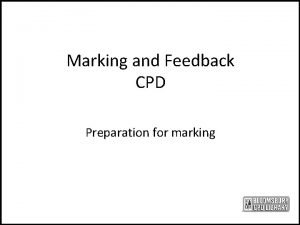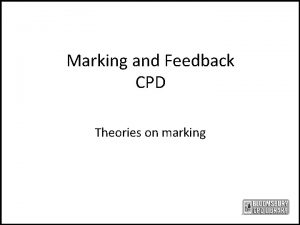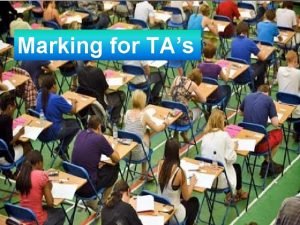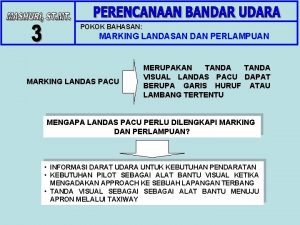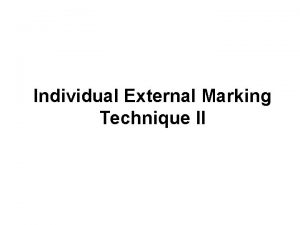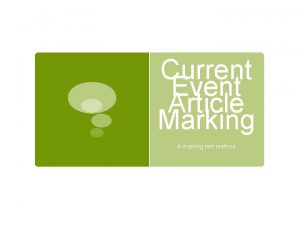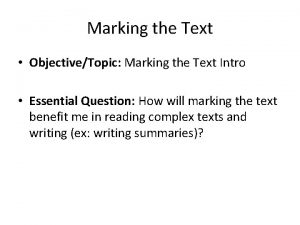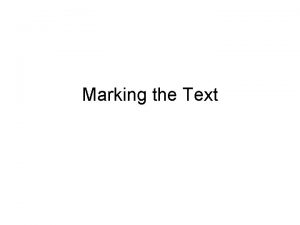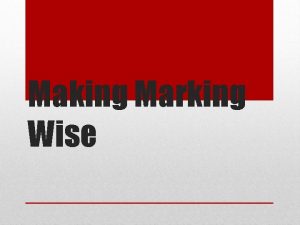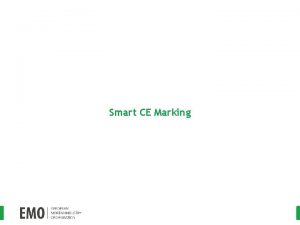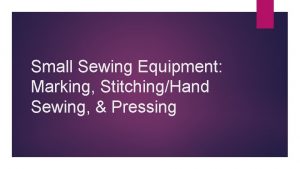SCANSION the process of analyzing and marking the































- Slides: 31

SCANSION the process of analyzing and marking the type and number of feet in a line of verse. Verb – to scan

METER the pattern of stressed and unstressed syllables established in a line of poetry.

STRESS stress is measured by a syllable’s volume, length, and pitch/intonation. / - stressed syllable ˘ - unstressed syllable

Factors Influencing Stress 1. Normal Pattern of stress in the pronunciation of individual words and phrases other provide on the top individual dangerous

Factors Influencing Stress 2. Relative importance of the words in the line. Look at me.

Factors Influencing Stress 3. The word’s grammatical functions influence their stress. Nouns, verbs, and adjectives tend to be accented more strongly to show their importance, while articles and prepositions are usually less stressed.

FOOT A foot is a unit of meter. A metrical foot can have two or three syllables. A foot consists generally of one stressed and one or more unstressed syllables.

Types of Metric Feet The basic types of metrical feet determined by the arrangement of stressed and unstressed syllables are: iambic anapestic spondaic trochaic dactylic pyrrhic

IAMB The iambic foot is a two-syllable foot with the stress on the second syllable. The iambic foot is the most common foot in English. A book | of ver | ses un | der neath | the bough. A jug | of wine, | a loaf | of bread | and thou.

TROCHEE The trochaic foot consists of a stressed syllable followed by an unstressed syllable. Dou ble, | dou ble, | toil and | trouble, Fire | burn and | cauldron | bubble

ANAPEST The anapestic foot consists of three syllables with the stress on the last syllable With the sheep | in the fold | and the cows | in their stalls.

DACTYL The dactylic foot contains three syllables with the stress on the first syllable. Love again, | song again | nest again, | young again.

SPONDEE The spondaic foot consists of two stressed syllables. Compound words are examples of spondees. They are used for variation. heartbreak, childhood, football

PYRRHIC The pyrrhic foot consists of two unstressed syllables. This type of foot is rare and is found interspersed with other feet. When the blood creeps | and the nerves prick

KINDS OF METRICAL LINES monometer—one-foot line dimeter—two-foot line trimeter—three-foot line tetrameter—four-foot line pentameter—five-foot line hexameter—six-foot line heptameter—seven-foot line octometer—eight-foot line

NAMING THE METER (type of foot) + (type of metrical line) Iambic Pentameter Trochaic Tetrameter Iambic Dimeter Alternating Lines of Iambic Pentameter and Trochaic Tetrameter

You Try It: 1. Unstressed syllable followed by stressed syllable; 8 syllables per line. IAMBIC TETRAMETER 2. Foot = trochee; 3 feet per line. TROCHAIC TRIMETER 3. Two unstressed syllables followed by a stressed syllable. 6 feet per line. ANAPESTIC HEXAMETER 4. Foot = dactyl; 24 syllables per line. DACTYLIC OCTOMETER

SCANSION The woods decay, the woods decay and fall, The vapors weep their burden to the ground, Man comes and tills the field and lies beneath, And after many a summer dies the swan. --Alfred, Lord Tennyson, “Tithonus”

SCANSION Earth, receive an honoured guest: William Yeats is laid to rest. Let the Irish vessel lie Emptied of its poetry. --WH Auden, “In Memory of W. B. Yeats”

SCANSION When a man hath no freedom to fight for at home, Let him combat for that of his neighbors; Let him think of the glories of Greece and of Rome, And get knocked on the head for labors. --Lord Byron, “When a Man Hath No Freedom to Fight for at Home”

SCANSION I went to the Garden of Love, And saw what I never had seen: A Chapel was built in the midst Where I used to play on the green. --William Blake, “The Garden of Love”

VERSE FORMS The kinds of verse forms based on meter and rhyme are (A) rhymed verse, (B) blank verse, and (C) free verse. RHYMED VERSE: Rhymed verse consists of verse with end rhyme and usually with a regular meter BLANK VERSE: Blank verse consists of lines of iambic pentameter without end rhyme. FREE VERSE: Free verse consists of lines that do not have a regular meter and do not contain rhyme.

DEVICES OF SOUND RHYME: is the similarity of likeness of sound existing between two words. A true rhyme should consist of identical sounding syllables that are stressed and the letters preceding the vowels sounds should be different. Thus fun and run are TRUE or perfect rhymes because the vowel sounds are identical preceded by different consonants.

DEVICES OF SOUND Near, off, or slant rhyme: A rhyme based on an imperfect or incomplete correspondence of end syllable sounds. Common in the work of Emily Dickinson, for instance: It was not death, for I stood up, And all the dead lie down. It was not night, for all the bells Put out their tongues for noon.

DEVICES OF SOUND (POSITION OF RHYME) END RHYME: consists of the similarity occurring at the end of two or more lines of verse: I wish that my room had a FLOOR I don’t so much care for a DOOR But this walking AROUND Without touching the GROUND Is getting to be quite a BORE!

DEVICES OF SOUND (POSITION OF RHYME) INTERNAL RHYME: consists of the similarity occurring between two or more words in the same line of verse. Once upon a midnight DREARY, while I pondered, weak and WEARY,

DEVICES OF SOUND (KINDS OF RHYME) MASCULINE RHYME—occurs when one syllable of a word rhymes with another word: bend and send; bright and light

DEVICES OF SOUND (KINDS OF RHYME) FEMININE RHYME — occurs when the last two syllables of a word rhyme with another word: lawful and awful; lighting and fighting

DEVICES OF SOUND (KINDS OF RHYME) TRIPLE RHYME — occurs when the last three syllables of a word or line rhyme: victorious and glorious; quivering and shivering; battering and shattering

DEVICES OF SOUND (KINDS OF RHYME) RHYME SCHEME — is the pattern or sequence in which the rhyme occurs. The first sound is represented or designated as a, the second is designated as b, and so on. When the first sound is repeated, it is designated as a also.

DEVICES OF SOUND (KINDS OF RHYME) Whose woods these are I think I know. His house is in the village though. He will not see me stopping here To watch his woods fill up with snow. My little horse must think it queer To stop without a farmhouse near Beside the woods and frozen lake The coldest evening of the year. He gives his harness bells a shake To ask if there is some mistake The only other sound’s the sweep Of easy wind and down flake. The woods are lovely, dark and deep But I have promises to keep, And miles to go before I sleep. a a b b c c d d d d
 Elision scans
Elision scans Double double toil and trouble meter
Double double toil and trouble meter Meter and scansion calculator
Meter and scansion calculator Latin scansion
Latin scansion Elegiac couplet
Elegiac couplet Elegiac couplet scansion
Elegiac couplet scansion Downmeter
Downmeter Scan poem calculator
Scan poem calculator Latin scansion tool
Latin scansion tool Hexameter example
Hexameter example Romeo and juliet sonnet 18
Romeo and juliet sonnet 18 Words that rhyme with rights
Words that rhyme with rights Scansion latin tool
Scansion latin tool Iliad scansion
Iliad scansion Tick and flick marking
Tick and flick marking Rhino marking
Rhino marking Automated marking system
Automated marking system National 5 pe portfolio
National 5 pe portfolio Rag marking
Rag marking Drawing removable partial denture design
Drawing removable partial denture design Tripod marking in rpd
Tripod marking in rpd How to reply to a formal invitation
How to reply to a formal invitation Triathlon body marking
Triathlon body marking Helicopter winching area marking
Helicopter winching area marking Hazardous
Hazardous Marking bad clusters data hiding technique
Marking bad clusters data hiding technique Marking criteria
Marking criteria Claw hand
Claw hand Hand tool classification
Hand tool classification Groove bone marking
Groove bone marking Beach marking
Beach marking Heart surface anatomy
Heart surface anatomy
